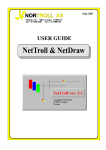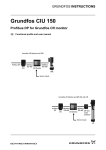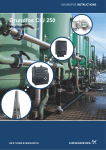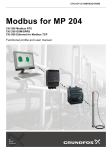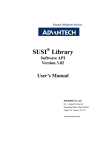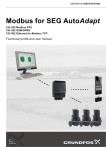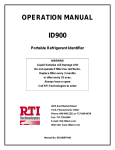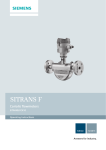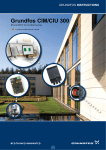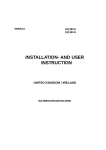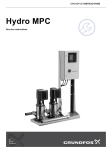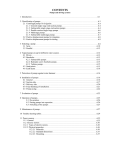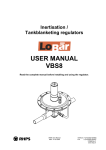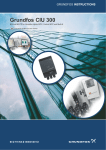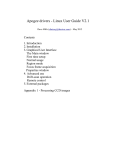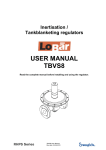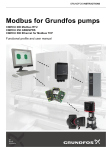Download Grundfos CIU 200
Transcript
GRUNDFOS INSTRUCTIONS Grundfos CIU 200 Modbus RTU for Grundfos CR Monitor Functional profile and user manual 1. Symbols used in this document Original installation and operating instructions. CONTENTS Page Caution If these safety instructions are not observed, it may result in malfunction or damage to the equipment! Note Notes or instructions that make the job easier and ensure safe operation. 1. Symbols used in this document 2 2. 2.1 2.2 2.3 2.4 2.5 Introduction About this functional profile Assumptions Definitions and abbreviations System diagrams Specifications 2 2 2 2 3 4 2. Introduction 3. 3.1 Modbus interface Modbus bus topology 5 5 This functional profile describes the CIU 200 (Modbus Communication Interface Unit 200) for the Grundfos CR Monitor. 4. 4.1 4.2 4.3 4.4 4.5 4.6 4.7 CIM 200 Modbus module Connecting to the Modbus network Setting the Modbus transmission speed Setting the parity Modbus address selection Termination resistor Cable length LEDs 5 6 6 6 7 7 7 7 5. 5.1 5.2 5.3 5.4 5.5 5.6 Functional profile Register block overview CIM configuration register block CIM status register block CR Monitor control register block CR Monitor status register block CR Monitor data register block 8 8 8 9 9 10 13 6. 6.1 6.2 Detailed descriptions Control modes Setpoint 14 14 15 7. 7.1 Commissioning Step-by-step guide to hardware setup (CIU 200) 16 16 8. 8.1 8.2 Fault finding LED Status Modbus communication faults 16 16 17 9. Data item overview 18 10. Grundfos alarm and warning codes 20 11. Modbus address 22 12. 12.1 12.2 12.3 12.4 12.5 12.6 12.7 12.8 Modbus telegrams and function codes Modbus telegram overview Function code overview Read holding registers (0x03) Read input registers (0x04) Write single register (0x06) Write multiple registers (0x10) Diagnostics (0x08) Diagnostics register interpretation 23 23 23 24 24 24 25 26 27 13. 13.1 13.2 13.3 13.4 Modbus telegram examples Diagnostics return query data Reading the CIM configuration register block Setting the setpoint Setting the control mode 28 28 28 28 28 2 2.1 About this functional profile In the following, the CIU 200 is referred to as "communication interface", and the Grundfos CR Monitor is referred to as "controller". The data in this document are subject to change without prior notice. Grundfos cannot be held responsible for any problems caused directly or indirectly by using information in this functional profile. 2.2 Assumptions This functional profile assumes that the reader is familiar with commissioning and programming Modbus devices. The reader should also have some basic knowledge of the Modbus protocol and technical specifications. It is also assumed that an existing Modbus RTU network with a Modbus master is present. 2.3 Definitions and abbreviations CIM 200 Communication Interface Module (built into the CIU 200) CIU 200 Communication Interface Unit CR Grundfos multistage centrifugal pump CRC Cyclic Redundancy Check, a data error detection method CRE Grundfos multistage centrifugal pump with variable-speed motor Derivation cable Stub cable GENIbus Proprietary Grundfos fieldbus standard H Pressure (Head) IO 351 Grundfos Input/Output module LED Light-Emitting Diode Modbus A serial communications protocol commonly used in industry and building services MP 204 Electronic Grundfos Motor Protector Q Flow RTU Remote Terminal Unit Transmission speed Bits transferred per second Trunk cable Main RS-485 cable on Modbus network 2.4 System diagrams The CR Monitor offers advanced monitoring of a Grundfos CRE pump or a Grundfos MP 204 motor protector connected to a CR pump. The system diagrams give an overview of how to connect the CIU 200 to the Grundfos CR Monitor that is to be connected to a Modbus network. A CR Monitor is connected to either a CRE pump or an MP 204 connected to a CR pump. The CIU 200 has a number of sensor inputs that can be connected directly to sensors, or it can get sensor inputs from a Grundfos IO 351 module. The CIU 200 offers a Modbus RTU connection to the CR Monitor. Note that the CR Monitor must have a GENIbus RS-485 module installed. The CIU 200 solution is a box with a power supply module and a CIM 200 module. The CIU 200 can either be mounted on a DIN rail or on a wall. See fig. 1 or 2. Modbus Modbus RTU RTU CIU GENIbus GENIbus RS-485 RS-485 CR Monitor CR Monitor GENIbus GENIbuss RS-485 RS-485 CRE CRE Sensorinputs inputs Sensor Fig. 1 TM04 4278 1109 GrundfosCR CR Monitor Monitor and CRE Grundfos and CRE CR Monitor connected to a CRE pump Grundfos CR Monitor and MP 204 with CR Modbus Modbus RTU RTU GENIbus GENIbus GENIbus GENIbus RS-485 RS-485 RS-485 RS-485 MP 204 CIU CR Monitor CIU CR Monitor MP 204 motor motor or protector protector Sensor Sensorinputs inputs CR CR Fig. 2 TM04 4279 1109 Grundfos CR Monitor and MP 204 with CR CR Monitor connected to an MP 204 which is connected to a CR pump 3 2.5 Specifications The table below gives an overview of the specifications for the Grundfos CIU 200. For further details, please refer to the specific sections of this functional profile. General data GENIbus visual diagnostics LED2 Off, constantly green, flashing red, constantly red. See section 4.7.2 LED2, internal communication. Communication Interface Unit (CIU 200) Power supply 24-240 V GENIbus connection type RS-485 GENIbus wire configuration Three-wire + screen Located in the CIU 200. Conductors: A, B and Y. Modbus specifications Data protocol Modbus RTU Modbus connector Screw-type terminal Modbus connection type RS-485 Modbus wire configuration Two-wire + common 3 pins. See section 4. CIM 200 Modbus module. Conductors: D0, D1 and Common. See section 4.1 Connecting to the Modbus network. Maximum trunk cable length 1200 m Equals 4000 ft. Maximum derivation cable length 250 m (at 38400 bits/s) Equals 820 ft. Slave address 1-247 Set via rotary switches SW6 and SW7. See section 4.4 Modbus address selection. Line termination On or Off Set via DIP switches SW1 and SW2. See section 4.5 Termination resistor. Supported transmission speeds 1200*, 2400*, 4800*, 9600, 19200, 38400 bits/s Set via DIP switches SW4 and SW5. See section 4.2 Setting the Modbus transmission speed. (*Can only be set by software). Start bit 1 Fixed value. Data bits 8 Fixed value. Stop bits 1 or 2 Set via DIP switch SW3. See section 4.3 Setting the parity. Parity bit Even parity or no parity Set via DIP switch SW3. See section 4.3 Setting the parity. Modbus visual diagnostics LED1 Off, constantly green, flashing red, constantly red. See section 4.7.1 LED1, Modbus communication. Maximum number of Modbus devices 32 Using repeaters, this number can be increased. Address range is 1-247. 4 3. Modbus interface 4. CIM 200 Modbus module 3.1 Modbus bus topology The Grundfos CIM/CIU 200 is connected as a Modbus slave directly to the Modbus RTU network. This is done either in daisy chain style, or using a passive TAP and a derivation cable (stub). Both methods are exemplified below. Master Passive TAP* 8 Slave Example of Modbus network with termination In such a network, only one master device is connected to the serial bus, and one or several (maximum 247) slaves are also connected to the serial bus. Slaves cannot communicate with each other and will never transmit data without receiving a request from the master device. Up to 32 devices can be connected to one RS-485 Modbus system without using a repeater. To implement a larger number of devices, use a repeater to connect the smaller networks to larger networks. Repeaters are also used to extend the maximum transmission distance. Fig. 4 Pos. 4 5 6 7 TM04 1697 0908 1 2 3 LT = Line Termination (termination resistor) Fig. 3 9 TM04 1947 1508 Slave Slave Daisy chain Slave Slave CIM 200 Modbus module Designation Description 1 D1 Modbus terminal D1 (positive data signal) 2 D0 Modbus terminal D0 (negative data signal) 3 Common/GND Modbus terminal Common/GND 4 SW1/SW2 On/off switches for termination resistor 5 SW3/SW4/SW5 Switches for selection of Modbus parity and transmission speed 6 LED1 Red/green status LED for Modbus communication 7 LED2 Red/green status LED for internal communication between the CIM 200 and the CR Monitor 8 SW6 Hex switch for setting the Modbus address (four most significant bits) 9 SW7 Hex switch for setting the Modbus address (four least significant bits) 5 4.1 Connecting to the Modbus network 4.3 Setting the parity A screened, twisted-pair cable must be used. The cable screen must be connected to protective earth at both ends. The parity can be set either manually by using SW3 or via software-defined settings. Recommended connection Manual setting of parity Colour code Data signal The CIM 200 only supports the Modbus RTU mode and hence cannot communicate with Modbus ASCII mode devices. D1-TXD1 Yellow Positive Default byte format (11 bits): D0-TXD0 Brown Negative • 1 start bit Common/GND • 8 data bits (least significant bit sent first) • 1 parity bit (even parity) 4.2 Setting the Modbus transmission speed • 1 stop bit. The transmission speed must be set correctly before the CIM 200 Modbus module is ready to communicate with the Modbus network. DIP switches SW4 and SW5 are used for setting the transmission speed. See fig. 5. The default setting of the CIM 200 Modbus module is even parity (1 stop bit). It is possible to change the parity with DIP switch SW3. The parity can be changed to no parity (2 stop bits). See fig. 6. Grey TM04 1710 0908 Common SW4 SW5 Fig. 5 Modbus transmission speed setting SW3 Fig. 6 4.2.1 DIP switch settings TM04 1709 0908 Modbus terminal Parity DIP switch settings Available transmission speeds in bits/s: 1200, 2400, 4800, 9600, 19200 and 38400. The first three transmission speeds are only available via software settings, whereas the last three are available via DIP switches SW4 and SW5. Parity SW3 Even parity, 1 stop bit OFF No parity, 2 stop bits ON Software-defined parity and stop bit Transmission speed SW4 SW5 9600 bits/s OFF ON 19200 bits/s OFF OFF 38400 bits/s ON OFF Software-defined ON ON When SW4 and SW5 are set to "software-defined", the value in holding registers at addresses 00009 and 00010 will override the setting of SW3. See figs 5 and 6. Software-defined parity Set register value 00009 The default transmission speed is 19200 bits per second, as per the Modbus RTU standard. No parity [default] Even parity 1 The transmission speed will be effective immediately after setting the values of the DIP switch. Odd parity 2 Software-defined When SW4 and SW5 are set to "software-defined", writing a value to the holding register at address 00004 will set a new transmission speed. Use the following values for software-defined transmission speeds: Software-defined transmission speed 0 2400 bits/s 1 4800 bits/s 2 9600 bits/s 3 19200 bits/s 4 38400 bits/s 5 This value is set to 1200 bits/s as default. The communication interface does not support transmission speeds above 38400 bits/s. The software-defined transmission speed value will be stored in the communication interface and will remain after a power-off. 6 When software-defined transmission speed is enabled (ON), software-defined parity and stop bit are also enabled. Set register value 00010 1 stop bit [default] 1 2 stop bits 2 The software-defined parity and stop bit values will be stored in the communication interface and will remain after a power-off. Set register value 00004 1200 bits/s Note Software-defined stop bit 0 Note Before the parity and stop bit can be set via software-defined settings, SW4 and SW5 must be set to ON. 4.4 Modbus address selection 4.7 LEDs A Modbus slave on a Modbus network must have a unique address from 1 to 247. Address 0 is reserved for broadcasting, and is not a valid slave address. The CIM/CIU 200 has two LEDs. • Red/green status LED (LED1) for Modbus communication between master and slave To set the Modbus address, two hexadecimal rotary switches (SW6 and SW7) are used. See fig. 7. • Red/green status LED (LED2) for internal communication between the CIM/CIU 200 and the CR Monitor. SW6 Fig. 7 TM04 1706 0908 4.7.1 LED1, Modbus communication SW7 Setting the Modbus address For a complete overview of Modbus addresses, see section 11. Modbus address on page 22. 4.5 Termination resistor The termination resistor is fitted on the CIM 200 Modbus module and has a value of 150 Ω. TM04 1701 0908 The CIM 200 has a DIP switch with two switches (SW1 and SW2) for cutting the termination resistor in and out. Figure 8 shows the DIP switches in cut-out state. SW1 SW2 Fig. 8 Cutting the termination resistor in and out DIP switch settings Status SW1 Cut-in Cut-out Description Off No Modbus communication. Flashing green Modbus communication active. Flashing red Fault in the Modbus communication. Constantly red Fault in the CIM 200 Modbus configuration. 4.7.2 LED2, internal communication The Modbus address must be set decimally from 1 to 247. Note Status Status Description Off The CIM/CIU 200 has been switched off, or is starting up. Flashing red No internal communication between the CIM/CIU 200 and the CR Monitor. Constantly red The CIM/CIU 200 does not support the CR Monitor connected. Constantly green Internal communication between the CIM/CIU 200 and the CR Monitor is OK. Note During start-up, there may be a delay of up to 5 seconds before the LED2 status is updated. Note The CR Monitor must have finished its start-up sequence before the LED2 can be used for status. This means that a certain delay may occur before the LED2 turns green after start-up of the CR Monitor. SW2 ON ON OFF OFF ON OFF OFF ON Default setting: Termination resistor cut-out. 4.6 Cable length The trunk cable must not exceed a total length of 1,200 m (4,000 ft). Grundfos recommends the following maximum cable lengths: Maximum cable length bits/s Terminated cable Unterminated cable [m/ft] [m/ft] 9600 bits/s 1200/4000 1200/4000 19200 bits/s 1200/4000 500/1700 38400 bits/s 1200/4000 250/800 Note To ensure a stable and reliable communication, it is important that only the termination resistor of the first and last units in the Modbus network are cut in. See fig. 3. 7 5. Functional profile 5.1 Register block overview The Modbus RTU registers are grouped in the following register blocks: Start address Register block Permissions Description 00001 CIM configuration R/W Configuration of the CIM module. 00021 CIM status R Status registers for the CIM module. 00101 CR Monitor control R/W Registers for control of the CR Monitor and the pump. 00201 CR Monitor status R Registers for reading mode status from the CR Monitor and the pump. 00301 CR Monitor data R Registers for reading measured data values from the CR Monitor and the pump. All addresses contain registers. Some are bit-interpreted while others are 16-bit values, or part of 32-bit values. 5.2 CIM configuration register block Registers in this block can be read by means of function codes 0x03 and/or 0x04. They can be written as holding registers with function codes 0x06 and 0x10. Address Register name Description SlaveMinimumReplyDelay The minimum reply delay from the slave in ms. Value range: 0-10000, i.e. up to 10 seconds reply delay. This delay is typically used in conjunction with a modem. The delay value is stored in the device and will remain after a power-off. The delay set here will be added to the internal delay in the device. Default value is 0. 00002 RegisterOffset An address offset that is added to all addresses above 00100. Default value is 0. Note: This offset does not affect the CIM configuration register block or the CIM status register block addresses. The register offset value is stored in the device and will remain after a power-off. For most applications, this offset should not be changed. 00003 If the Modbus address switch has not been set correctly, i.e. not within the 1 to 247 range, the value in this register is used as Modbus address. SoftwareDefinedModbusAddress See section 4.4 Modbus address selection. The value is stored in the device and will remain after a power-off. Default value of this register is 0xE7 (231). 00004 SoftwareDefinedBitRate Modbus software-defined transmission speed enumeration. The software-defined transmission speed value is stored in the device and will remain after a power-off. 0 = 1200 bits/s 1 = 2400 bits/s 2 = 4800 bits/s 3 = 9600 bits/s 4 = 19200 bits/s 5 = 38400 bits/s. Note: This value is used only when the transmission speed is set to "software-defined" on the DIP switches SW4 and SW5. Otherwise, it will be ignored by the slave. 00005 AutoAckControlBits Used to select the behaviour of control bit acknowledgements from the CIU 200. 0 = Disabled. Control bits are not automatically lowered when accepted by the device. The user must lower the triggered control bit manually before the control bit can be triggered again. 1 = Enabled. Control bits are automatically lowered when accepted by the device. The user does not have to lower it manually [default]. 00006 RESERVED - 00007 RESERVED - 00008 RESERVED - 00009 SoftwareDefinedParity Parity setting to be used when using "software-defined" settings. 0 = No parity [default] 1 = Even parity 2 = Odd parity. 00010 SoftwareDefinedStopBit Stop bit setting to be used when using "software-defined" settings. 0 = No stop bit 1 = 1 stop bit [default] 2 = 2 stop bits. 00001 8 5.3 CIM status register block Registers in this block can be read by means of function codes 0x03 and/or 0x04. They are read-only. This block can be used for various kinds of fault finding. Address Register name Description 00021 GrundfosCRCErrorCnt Holds a CRC error counter for the GENIbus connection between the CIU 200 and the CR Monitor. 00022 GrundfosDataErrorCnt Holds a data error counter for the GENIbus connection between the CIU 200 and the CR Monitor. 00023 VersionNumber A Grundfos-specific version number. This is an unsigned integer value. 00024 ActualModbusAddress Holds the current Modbus slave address of the device. Valid value range: 1…247. 00025 00026 GrundfosTXcountHI GrundfosTXcountLO Holds a transmit counter for total number of telegrams sent to the CIU 200 on the GENIbus connection. 00027 00028 GrundfosRXcountHI GrundfosRXcountLO Holds a receive counter for total number of telegrams received from the CIU 200 on the GENIbus connection. 00029 RESERVED - 00030 UnitFamily Grundfos product family. 00031 UnitType Grundfos product type. 00032 UnitVersion Grundfos product version. 5.4 CR Monitor control register block Registers in this block can be read by means of function codes 0x03 and/or 0x04. They can be written as holding registers with function codes 0x06 and 0x10. Address Register name Description ControlRegister Bits 3-15: RESERVED - ControlRegister Bit 2: ResetAlarm Control bit that resets alarms and warnings. 0 = No resetting 1 = Resetting alarm. This control bit is triggered on rising edge only, i.e. setting logical 0 to 1. See section 5.2 CIM configuration register block, address 00005, for acknowledgement behaviour. ControlRegister Bit 1: OnOffReq Control bit that switches the pump/MP 204 on and off. 0 = Off (stop) 1 = On (start). ControlRegister Bit 0: RemoteAccessReq Control bit that sets local or remote control. 0 = Local 1 = Remote (controlled by Modbus master). This bit must be 1 if the pump/MP 204 is to be controlled by a Modbus master. ControlMode Sets the control mode enumeration. 0 = CONST_SPEED (constant speed) 1 = CONST_FREQ (constant frequency) 3 = CONST_HEAD (constant head) 4 = CONST_PRESSURE (constant pressure) 5 = CONST_DIFFPRESS (constant differential pressure) 6 = VAR_DIFFPRESS (variable differential pressure) 7 = CONST_FLOW (constant flow) 8 = CONST_TEMP (constant temperature) 10 = CONST_LEV (constant level) 128 = AUTO_PRESS_MODE (automatic mode). See section 6.1 Control modes for details. OperationMode A state enumeration to control the pump operating mode. 0 = Auto-control (setpoint control) 4 = OpenLoopMin (running at minimum speed) 6 = OpenLoopMax (running at maximum speed). Note: OnOffReq has higher priority than the OperationMode, meaning that OnOffReq must be set to on for the OperationMode to have any effect. See section 6.1 Control modes for details. Setpoint Sets the pump setpoint (not used on systems with MP 204). Scale is 0.01 %, with value range [0; 10000]. Closed loop Percentage of closed-loop feedback sensor range. Open loop Percentage of pump performance. Common examples 4700 = 47 % 8000 = 80 %. See section 6.2 Setpoint. 00101 00102 00103 00104 9 5.5 CR Monitor status register block Registers in this register block can be read by means of function codes 0x03 and/or 0x04. They are read-only. Address 00201 00202 00203 10 Register name Description StatusRegister Bit 15: AtMinSpeed Indicates if the CRE pump is running at minimum speed. 0 = No 1 = Yes. Not available on the CR pump. StatusRegister Bit 14: RESERVED - StatusRegister Bit 13: AtMaxSpeed Indicates if the CRE pump is running at maximum speed. 0 = No 1 = Yes. Not available on the CR pump. StatusRegister Bit 12: RESERVED - StatusRegister Bit 11: Warning Indicates if there is a warning or not. The pump will continue running even if there is a warning. 0 = No warning 1 = Warning. StatusRegister Bit 10: Fault Indicates if there is a fault or not. 0 = No fault 1 = Fault. StatusRegister Bit 9: OnOff Indicates if the pump is on or not. 0 = Off (stopped) 1 = On (started). Started does not necessarily indicate rotation, for instance in case of low-flow stop. StatusRegister Bit 8: AccessMode Indicates if the pump is locally or remotely controlled. 0 = Local (a local control source with higher priority controls the pump). 1 = Remote (controlled by Modbus master). StatusRegister Bit 7: RESERVED - StatusRegister Bit 6: Rotation Indicates if the pump is rotating (running) or not. 0 = No rotation 1 = Rotation. StatusRegister Bits 4-5: RESERVED - StatusRegister Bit 3: ResetAlarmAck Indicates if a ResetAlarm was acknowledged by the device. This bit will be set when the CIU 200 has accepted the ResetAlarm control bit, and the user can clear the ResetAlarm bit. The CIU 200 will automatically clear the ResetAlarmAck bit to 0 when the user clears the ResetAlarm bit, and a new ResetAlarm can be attempted by raising the ResetAlarm control bit again. 0 = No acknowledgement 1 = Control bit acknowledged. This functionality is only used when AutoAckControlBits is disabled. See section 5.2 CIM configuration register block. StatusRegister Bits 0-2: RESERVED - ProcessFeedback Indicates the actual process feedback from the CRE pump. The scale is 0.01 %, so the valid value range is from 0 to 10000. This value can be compared with the setpoint value. Closed loop Percentage of closed-loop feedback sensor range. Open loop Percentage of CRE pump performance. Common examples 4700 = 47 % 8000 = 80 %. ControlMode Indicates the actual control mode. 0 = CONST_SPEED (constant speed) 1 = CONST_FREQ (constant frequency) 3 = CONST_HEAD (constant head) 4 = CONST_PRESSURE (constant pressure) 5 = CONST_DIFFPRESS (constant differential pressure) 6 = VAR_DIFFPRESS (variable differential pressure) 7 = CONST_FLOW (constant flow) 8 = CONST_TEMP (constant temperature) 10 = CONST_LEV (constant level) 128 = AUTO_PRESS_MODE (automatic mode). Address Register name Description OperationMode Indicates the actual operating mode. 0 = Auto-control (setpoint control) 4 = OpenLoopMin (running at minimum speed) 6 = OpenLoopMax (running at maximum speed). 00205 AlarmCode The Grundfos-specific alarm code. See section 10. Grundfos alarm and warning codes. 00206 WarningCode The Grundfos-specific warning code. See section 10. Grundfos alarm and warning codes. 00204 Bits 9-15: RESERVED - Bit 8: BearingServiceType Indicates the type of the next bearing service. 0 = Lubricate bearings 1 = Change bearings. Bits 0-7: MonthsToBearingService Indicates the number of months until the next bearing service. This value can be 0, 1, 3, 6, 12 and 24 months, if available. A value of 24 months means "24 months or more". A value of 0xFF indicates that the information is not available. 00208.0 MonitorLearningActivated Indicates the activation status of the CR Monitor learning function. 0 = Not activated 1 = Activated. 00208.1 MonitorLearningOperating Indicates the operating status of the CR Monitor learning function. 0 = Not operating 1 = Operating. 00208.2 MonitorLearningDataQuality Indicates the data stability of the CR Monitor learning function. 0 = Unstable data 1 = Stable data. ControllerFaults Indicates controller faults. Bit 0: RESERVED Bit 1: FLASH parameter verification error (code 83) Bit 2: Ethernet: No IP address from DHCP server (code 231) Bit 3: Ethernet: Auto-disabled due to misuse (code 232). MonitorAlarms1 Alarm bits for the monitoring system. Bit 0: Maximum inlet pressure alarm limit exceeded Bit 1: Minimum inlet pressure alarm limit exceeded Bit 2: Maximum discharge pressure alarm limit exceeded Bit 3: Minimum discharge pressure alarm limit exceeded Bit 4: Maximum differential-pressure alarm limit exceeded Bit 5: Minimum differential-pressure alarm limit exceeded Bit 6: Maximum flow alarm limit exceeded Bit 7: Minimum flow alarm limit exceeded Bit 8: Maximum supply voltage alarm limit exceeded Bit 9: Minimum supply voltage alarm limit exceeded Bit 10: Maximum speed alarm limit exceeded Bit 11: Minimum speed alarm limit exceeded Bit 12: Maximum power alarm limit exceeded Bit 13: Minimum power alarm limit exceeded Bit 14: Minimum efficiency alarm limit exceeded Bit 15: Minimum cavitation alarm limit exceeded. MonitorAlarms2 Alarm bits for the monitoring system. Bit 0: Maximum Q, H alarm limit exceeded Bit 1: Maximum Q, P alarm limit exceeded Bit 2: Start trip counter alarm limit exceeded Bit 3: Maximum lubrication time alarm limit exceeded Bit 4: RESERVED Bit 5: RESERVED Bit 6: Pump fault Bits 7-15: RESERVED. MonitorWarnings1 Warning bits for the monitoring system. Bit 0: Maximum inlet pressure warning limit exceeded Bit 1: Minimum inlet pressure warning limit exceeded Bit 2: Maximum discharge pressure warning limit exceeded Bit 3: Minimum discharge pressure warning limit exceeded Bit 4: Maximum differential-pressure warning limit exceeded Bit 5: Minimum differential-pressure warning limit exceeded Bit 6: Maximum flow warning limit exceeded Bit 7: Minimum flow warning limit exceeded Bit 8: Maximum supply voltage warning limit exceeded Bit 9: Minimum supply voltage warning limit exceeded Bit 10: Maximum speed warning limit exceeded Bit 11: Minimum speed warning limit exceeded Bit 12: Maximum power warning limit exceeded Bit 13: Minimum power warning limit exceeded Bit 14: Minimum efficiency warning limit exceeded Bit 15: Minimum cavitation warning limit exceeded. 00207 00209 00210 00211 00212 11 Address 00213 00214 00215 12 Register name Description MonitorWarnings2 Warning bits for the monitoring system. Bit 0: Maximum Q, H warning limit exceeded Bit 1: Maximum Q, P warning limit exceeded Bit 2: Start trip counter warning limit exceeded Bit 3: Maximum lubrication time warning limit exceeded Bit 4: RESERVED Bit 5: RESERVED Bit 6: Pump warning Bits 7-15: RESERVED. MP 204Warnings1 Warning bits for MP 204, if installed. Bit 0: Maximum voltage warning Bit 1: Minimum voltage warning Bit 2: Maximum line current warning Bit 3: Minimum line current warning Bit 4: Line current asymmetry warning Bit 5: RESERVED Bit 6: RESERVED Bit 7: RESERVED Bit 8: Insulation resistance warning Bit 9: Motor temperature (Tempcon) warning Bit 10: Motor temperature (PT resistor) warning Bit 11: RESERVED Bit 12: Maximum cos φ warning limit exceeded Bit 13: Minimum cos φ warning limit exceeded Bit 14: Starts per hour warning Bit 15: Starts per hour warning limit exceeded. MP 204Warnings2 Warning bits for MP 204, if installed. Bit 0: Start capacitor min. warning Bit 1: RESERVED Bit 2: Run capacitor min. warning Bit 3: Tempcon sensor signal fault warning Bit 4: Pt sensor signal fault warning Bit 5: Service warning: t_run_trip_cnt > t_run_trip_warn Bit 6: Load continues even if the motor has been switched off Bits 7-15: RESERVED. 5.6 CR Monitor data register block Registers in this block can be read by means of function codes 0x03 and/or 0x04. They are read-only. The table below shows the availability of the data, depending on system configuration. Address Register name Scale 00301 InletPressure (offset = 1 bar) 0.001 bar 00302 OutletPressure 0.001 bar 00303 VolumeFlow 0.1 m3/h 00304 Speed 1 rpm 00305 Frequency 0.1 Hz 00306 DigitalInput bits 00307 DigitalOutput bits 00308 ActualSetpoint Available with CRE pump only. 0.01 % 00309 MotorCurrent 0.1 A 00310 MotorTemp Available if a Pt100 sensor is used. 0.01 K 00311 MotorVoltage 0.1 V 00312 CalculatedPower 1W 00313 00314 PowerHI PowerLO 1W 00315 PumpLiquidTemp 0.01 K 00316 AuxSensorInput 0.01 % 00317 00318 OperationTimeHI OperationTimeLO 1 hour 00319 00320 TotalPoweredTimeHI TotalPoweredTimeLO 1 hour 00321 00322 EnergyHI EnergyLO 1 kWh 00323 00324 NumberOfStartsHI NumberOfStartsLO 1 start 00325 DifferentialPressure 0.001 bar 00326 CalculatedDifferentialPressure 0.001 bar 00327 CalculatedEfficiency 0.01 % 00328 MeasuredEfficiency 0.01 % 00329 NPSHAvailable 0.01 m 00330 NPSHRequired 0.01 m 00331 CavitationMargin 0.01 m A data value of 0xFFFF indicates "not available". See section 9. Data item overview for more information on this register block. 13 6. Detailed descriptions 6.1 Control modes The supported control modes are described further in this section. > CONST_SPEED > CONST_FREQ Open loop The setpoint of the CRE pump will be interpreted as setpoint for the pump speed. The setpoint value is a percentage of the maximum speed of the pump. No sensor is required in these modes. Illustration H Q > CONST_HEAD > CONST_PRESSURE > CONST_DIFFPRESS Closed loop The setpoint of the CRE pump will be interpreted as setpoint for the pressure. The controller in the pump will change the pump speed so that the pressure is constant, regardless of the flow. A pressure sensor is required. H Q > VAR_DIFFPRESS Closed loop The setpoint of the CRE pump will be interpreted as basic setpoint for the VAR_DIFFPRESS mode (the black dot in the drawing). This control mode is only available on TPE Series 2000 pumps. A pressure sensor is required. H = Pressure (Head) Q = Flow 14 H Q TM04 2288 2208 Closed loop The setpoint of the CRE pump will be interpreted as setpoint for the flow, temperature or level. CONST_FLOW is illustrated to the right. A relevant sensor is required: • a temperature sensor for temperature control, • a level sensor for level control and • a flow sensor for flow control. Q TM04 2291 2208 > CONST_FLOW > CONST_TEMP > CONST_LEV TM04 2289 2208 Description TM04 2290 2208 Control modes H 6.2 Setpoint This register accepts values ranging from 0 to 10000 (0 % to 100 %). This is illustrated in fig. 9. The setpoint is a percentage of the maximum setpoint or sensor maximum (max. = 100 %). The setpoint value can represent speed, pressure, flow, etc., depending on the selected control mode. A setpoint of 0 does not imply a stop. Minimum setpoint 0=0% Fig. 9 Setpoint [%] 10000 = 100 % TM04 2373 2508 Effective setpoint Sensor maximum Setpoint 6.2.1 Control modes Closed loop If the control mode is set to CONST_PRESS (closed loop), and the pressure sensor is in the range of 0 to 10 bar, a setpoint of 80 % will result in an effective setpoint of 8 bar. If the sensor range was 0-16 bar, a 50 % setpoint would be 8 bar, a 25 % setpoint would be 4 bar, and so on. 10 bar 0=0% 8000 = 80 % 10000 = 100 % TM04 2371 2508 8 bar Fig. 10 Constant pressure Open loop If the control mode is set to CONST_FREQ (open loop), the setpoint is interpreted as setpoint for the system performance. The example shows that a 50 % setpoint equals a 50 % system performance. Maximum system performance 0=0% 5000 = 50 % 10000 = 100 % TM04 2372 2508 50 % system performance Fig. 11 Constant frequency 15 7. Commissioning Note If the sensor configuration is changed, restart the CIU 200 to ensure a correct scaling of the sensor value. 7.1 Step-by-step guide to hardware setup (CIU 200) Step Description 1 Complete the CR Monitor system configuration, e.g. sensor configuration. 2 Select the Modbus slave address (1-247). See section 4.4 Modbus address selection. 3 Select the transmission speed of the Modbus slave. See section 4.2 Setting the Modbus transmission speed. 4 Select parity and stop bits of the Modbus slave (even-1 or none-2). See section 4.3 Setting the parity. 5 If necessary, set line termination. See section 4.5 Termination resistor. 6 Connect the GENIbus cable from the CIU 200 to the CR Monitor. 7 Connect the necessary cables from the CIU 200 to the Modbus network. See section 4.1 Connecting to the Modbus network. 8 Connect the power supply cable to the CIU 200, and switch the unit on. 9 Confirm that the GENIbus LED is constantly green and that the Modbus LED is either off (if no master is actively polling the slave) or flashing green (indicating communication). See section 4.7 LEDs. The CIU 200 is now ready to be accessed via the Modbus network. 8. Fault finding 8.1 LED Status Faults in a CIM/CIU 200 can be detected by observing the status of the two communication LEDs. See the table below. Fault (LED status) Possible cause Remedy 1. Both LEDs (LED1 and LED2 remain off when the power supply is connected and 5 seconds have passed. a) The CIM 200 is defective. • Replace the CIM 200. 2. The LED for internal communication (LED2) is flashing red. a) No internal communication between the CIM/CIU 200 and the Grundfos CR Monitor. • Check the cable connection between the CR Monitor and the CIU 200. • Check that the individual conductors have been fitted correctly. • Check the power supply to the CR Monitor. 3. The LED for internal communication (LED2) is constantly red. a) The CIU 200 does not support the CR Monitor connected. • Contact the nearest Grundfos company. 4. The Modbus LED (LED1) is constantly red. a) Fault in the CIM 200 Modbus configuration. • Check the transmission speed (switches SW4 and SW5). If the switches are set to "software-defined", an invalid value may have been set via Modbus. Try one of the pre-selected transmission speeds, e.g. 19200 bits/s. • Check that the Modbus address (switches SW6 and SW7) has a valid value (1-247). 5. The Modbus LED (LED1) is flashing red. a) Fault in the Modbus communication (fault in parity or cyclic redundancy check). 16 • Check the transmission speed (switches SW4 and SW5). • See section 4.2 Setting the Modbus transmission speed. • Check the parity setting (switch SW3). See section 4.3 Setting the parity. • Check the cable connection between the CIM 200 and the Modbus network. • Check the termination resistor settings (switches SW1 and SW2). See section 4.5 Termination resistor. 8.2 Modbus communication faults Fault Possible cause Remedy 1. The slave does not respond to telegrams. a) Configuration or wiring error. • Check the visual diagnostics on the Modbus slave. Is the Grundfos GENIbus LED flashing green and the Modbus LED off or flashing green. • Ensure that the cable between the Modbus master and the Modbus slave is connected correctly. See section 4.1 Connecting to the Modbus network for wiring recommendations. • Ensure that the slave address is configured correctly, and that the correct slave address is used in the Modbus master poll. See section 4.4 Modbus address selection for slave address selection. • Ensure that the transmission speed and stop bit/parity settings are configured correctly in both master and slave. See sections 4.2 Setting the Modbus transmission speed and 4.3 Setting the parity. • Ensure that each end of the Modbus trunk cable is terminated, if necessary. See section 4.5 Termination resistor for line termination of the Grundfos slave. • Ensure that the bus topology for a Modbus network is correct. See section 3.1 Modbus bus topology. b) The slave may be in listen-only mode. • Either send a restart communications diagnostics command, or restart the CIU 200 manually. c) If the holding register of address 00001 "SlaveMinimumReplyDelay" is set too high, the master may time out before receiving the response from the slave. • Increase the timeout span in the master in order to communicate. 2. The slave responds with exception response 0x01: "Invalid function". a) The master is trying to use an unsupported function in the CIM/CIU 200. • 3. The slave responds with exception response 0x02: "Invalid data address". a) The master is trying to read or write an invalid data address. If a master tries to read register addresses that are not listed in the tables, the slave will respond with this exception response. Some masters may automatically try to read large blocks in one telegram, which will cause problems if some of the registers in the block are not supported. An example would be reading the CIM configuration and CIM status register blocks in one telegram: this is not possible since there are unused addresses between the blocks. • Avoid reading or writing invalid data addresses. b) The register address offset may have been changed from default. • Read the holding register at address 00002 "RegisterOffset" to see if this value is different from 0. If so, write the value 0 to this address to make the slave return to the default used in this functional profile. 4. The slave returns data value 0xFFFF (65535). 5. The slave does not change Modbus transmission speed with register 0004. See section 12.2 Function code overview for supported function codes. Note that reading and writing coils are not supported, so only register functions and diagnostics will be valid. • See section 9. Data item overview for available a) The value is unavailable. A data value data. of 0xFFFF does not necessarily indicate an error condition. It means that the value is unavailable from the CR Monitor. b) The CR Monitor is not configured to show the value or lacks a sensor to read the value. • Ensure that the CR Monitor has been configured appropriately. a) Configuration error. • Set the transmission speed switches to "softwaredefined". Otherwise, the value in register 0004 is ignored by the slave. b) An invalid value may have been set in register 00004. • See section 4.2 Setting the Modbus transmission speed for invalid values, and set correct value in register 00004. 17 9. Data item overview bits: The data item is bit-interpreted. enum: The data item has a pre-defined enumeration. unscaled: The data item is unscaled (e.g. a number, a counter, etc.). CR Monitor + CRE CR Monitor + MP 204 and CR The list shows data item functionality support for a CR Monitor connected to either a CRE pump or an MP 204 and a CR pump. 00001 SlaveMinimumReplyDelay ms R/W Minimum Modbus reply delay in ms. ● ● 00002 RegisterOffset unscaled R/W Modbus address offset. ● ● 00003 ModbusAddress unscaled R/W Is used if the rotary switch value is invalid. ● ● 00004 ModbusBitRate unscaled R/W Software-defined transmission speed. ● ● 00005 AutoAckControlBits bool R/W Setup of event acknowledgement behaviour. ● ● 00009 SoftwareDefinedParity enum R/W Parity setting in "software-defined" mode. ● ● 00010 SoftwareDefinedStopBit enum R/W Stop bit setting in "software-defined" mode. ● ● Register Identifier Scale R/W Description CIM configuration register block CIM status register block 00021 GrundfosCRCErrorCnt unscaled R Grundfos GENIbus CRC error counter. ● ● 00022 GrundfosDataErrorCnt unscaled R Grundfos GENIbus data error counter. ● ● 00023 VersionNumber unscaled R Version number. ● ● 00024 ActualModbusAddress unscaled R Actual Modbus slave address. ● ● 00025 00026 GrundfosTXcountHI GrundfosTXcountLO unscaled R Grundfos GENIbus transmit counter. ● ● 00027 00028 GrundfosRXcountHI GrundfosRXcountLO unscaled R Grundfos GENIbus receive counter. ● ● ● 00030 UnitFamily unscaled R Grundfos product family. ● 00031 UnitType unscaled R Grundfos product type. ● ● 00032 UnitVersion unscaled R Grundfos product version. ● ● ● CR Monitor control register block 00101 ControlRegister bits W Control register for pump control. ● 00102 ControlMode enum W Sets the control mode. ● - 00103 OperationMode enum W Sets the operating mode. ● ● 00104 Setpoint 0.01 % W Reference value (pump setpoint). ● ● CR Monitor status register block 00201 StatusRegister bits R Actual modes. ● 00202 ProcessFeedback 0.01 % R Actual process feedback value. ● - 00203 ControlMode enum R Readout of the actual control modes. ● ● 00204 OperationMode enum R Readout of the actual operating mode. ● ● 00205 AlarmCode enum R Actual fault code/alarm code. ● ● 00206 WarningCode enum R Actual warning code. ● ● 00207 ServiceBlock bits R Bearing service information. ● ● 00208 MonitorLearning bits R Learning functions of the CR Monitor. ● ● 00209 ControllerFaults bits R Fault bits from the controller. ● ● 00210 MonitorAlarms1 bits R Alarm bits for the monitoring system. ● ● 00211 MonitorAlarms2 bits R Alarm bits for the monitoring system. ● ● 00212 MonitorWarnings1 bits R Warning bits for the monitoring system. ● ● 00213 MonitorWarnings2 bits R Warning bits for the monitoring system. ● ● 00214 MP 204Warnings1 bits R Warning bits for the MP 204. - ● 00215 MP 204Warnings2 bits R Warning bits for the MP 204. - ● CR Monitor data register block 00301 InletPressure 0.001 bar R Pump inlet pressure. Has offset of -1.0 bar. ● ● 00302 OutletPressure 0.001 bar R Pump discharge pressure. ● ● 00303 VolumeFlow 0.1 m3/h R Actual pump flow. ● ● 00304 Speed 1 rpm R Motor speed. ● ● 00305 Frequency 0.1 Hz R Actual control signal applied to motor. ● ● 18 CR Monitor + CRE CR Monitor + MP 204 and CR 00306 DigitalInput bits R External digital input signals. ● ● 00307 DigitalOutput bits R External digital output signals. ● ● 00308 ActualSetpoint 0.01 % R Actual setpoint (reference). ● ● 00309 MotorCurrent 0.1 A R Motor current. ● ● 00310 MotorTemp 0.01 K R Motor winding temperature. ● ● 00311 MotorVoltage 0.1 V R Motor voltage. ● ● 00312 CalculatedPower 1W R Calculated power consumption. ● ● 00313 00314 MeasuredPowerHI MeasuredPowerLO 1W R Measured power consumption. ● ● 00315 PumpLiquidTemp 0.01 K R Pumped-liquid temperature. ● ● 00316 AuxSensorInput 0.01 % R Auxiliary sensor input. ● ● 00317 00318 OperationTimeHI OperationTimeLO 1 hour R Total operating time of the pump. ● ● 00319 00320 TotalPoweredTimeHI TotalPoweredTimeLO 1 hour R Total power-on time of the pump. ● ● 00321 00322 EnergyHI EnergyLO 1 kWh R Energy consumption. ● ● 00323 00324 NumberOfStartsHI NumberOfStartsLO unscaled R Total number of starts. ● ● 00325 DifferentialPressure 0.001 bar R Pressure rise across the pump. ● ● Calculated pressure across the pump based on model. ● ● Register 00326 Identifier Scale R/W Description CalculatedDifferentialPressure 0.001 bar R 00327 CalculatedEfficiency 0.01 % R Calculated efficiency based on model. ● ● 00328 MeasuredEfficiency 0.01 % R Measured efficiency. ● ● ● ● 00329 NPSHAvailable 0.01 m R Net Positive Suction Head available at the pump inlet. 00330 NPSHRequired 0.01 m R Net Positive Suction Head required by Grundfos data. ● ● 00331 CavitationMargin 0.01 m R NPSH available (NPSHRequired + safety margin). ● ● 19 10. Grundfos alarm and warning codes This is a general Grundfos alarm and warning code list. Not all codes are available in the CR Monitor. Code Description Code Description Code Description 1 Leakage current 35 Gas in pump head, deaerating problem 76 Internal communication fault 2 Missing phase 36 Discharge valve leakage 77 Communication fault, twin-head pump 3 External fault signal 37 Suction valve leakage 78 Fault, speed plug 4 Too many restarts 38 Vent valve defective 79 Functional fault, add-on module 5 Regenerative braking 40 Undervoltage 80 Hardware fault, type 2 6 Mains fault 41 Undervoltage transient 81 Verification error, data area (RAM) 7 Too many hardware shutdowns 42 Cut-in fault (dV/dt) 82 Verification error, code area (ROM, FLASH) 8 PWM switching frequency reduced 45 Voltage asymmetry 83 Verification error, FE parameter area (EEPROM) 9 Phase sequence reversal 48 Overload 84 Memory access error 10 Communication fault, pump 49 Overcurrent (i_line, i_dc, i_mo) 85 Verification error, BE parameter area (EEPROM) 11 Water-in-oil fault (motor oil) 50 Motor protection function, general shutdown (mpf) 88 Sensor fault 12 Time for service (general service information) 51 Blocked motor/pump 89 Signal fault, (feedback) sensor 1 13 Moisture alarm, analog 52 Motor slip high 90 Signal fault, speed sensor 14 Electronic DC-link protection activated (ERP) 53 Kipped motor 91 Signal fault, temperature 1 sensor 15 Communication fault, main system (SCADA) 54 Motor protection function, 3 sec. limit 92 Calibration fault, (feedback) sensor 16 Other 55 Motor current protection activated (MCP) 93 Signal fault, sensor 2 17 Performance requirement cannot be met 56 Underload 94 Limit exceeded, sensor 1 18 Commanded alarm standby (trip) 57 Dry running 95 Limit exceeded, sensor 2 19 Diaphragm break (dosing pump) 58 Low flow 96 Setpoint signal outside range 20 Insulation resistance low 59 No flow 97 Signal fault, setpoint input 21 Too many starts per hour 64 Overtemperature 98 Signal fault, input for setpoint influence 22 Moisture switch alarm, digital 65 Motor temperature 1 (t_m or t_mo or t_mo1) 99 Signal fault, input for analog setpoint 23 Smart trim gap alarm 66 Temperature, control electronics (t_e) 104 Software shutdown 24 Vibration 67 Temperature too high, internal frequency converter module (t_m) 105 Electronic rectifier protection activated (ERP) 25 Setup conflict 68 External temperature/ water temperature (t_w) 106 Electronic inverter protection activated (EIP) 26 Load continues even if the motor has been switched off 69 Thermal relay 1 in motor (e.g. Klixon) 110 Skew load, electrical asymmetry 27 External motor protector activated (e.g. MP 204) 70 Thermal relay 2 in motor (e.g. thermistor) 111 Current asymmetry 28 Battery low 71 Motor temperature 2 (Pt100, t_mo2) 112 Cos ϕ too high 29 Turbine operation (impellers forced backwards) 72 Hardware fault, type 1 113 Cos ϕ too low 30 Change bearings (specific service information) 73 Hardware shutdown (HSD) 120 Auxiliary winding fault (single-phase motors) 31 Change varistor(s) (specific service information) 74 Internal supply voltage too high 121 Auxiliary winding current too high (single-phase motors) 32 Overvoltage 75 Internal supply voltage too low 122 Auxiliary winding current too low (single-phase motors) 20 Code Description Code Description Code Description 123 Start capacitor, low (single-phase motors) 183 Signal fault, extra temperature sensor 215 Soft pressure build-up timeout 124 Run capacitor, low (single-phase motors) 184 Signal fault, general-purpose sensor 216 Pilot pump alarm 144 Motor temperature 3 (Pt100, t_mo3) 185 Unknown sensor type 217 Alarm, general-purpose sensor high 145 Bearing temperature high (Pt100), in general or top bearing 186 Signal fault, power meter sensor 218 Alarm, general-purpose sensor low 146 Bearing temperature high (Pt100), middle bearing 187 Signal fault, energy meter 219 Pressure relief not adequate 147 Bearing temperature high (Pt100), bottom bearing 188 Signal fault, user-defined sensor 220 Fault, motor contactor feedback 148 Motor bearing temperature high (Pt100) in drive end (DE) 189 Signal fault, level sensor 221 Fault, mixer contactor feedback 149 Motor bearing temperature high (Pt100) in non-drive end (NDE) 190 Sensor limit 1 exceeded (e.g. alarm level in WW application) 222 Time for service, mixer 152 Communication fault, add-on module 191 Sensor limit 2 exceeded (e.g. high level in WW application) 223 Maximum number of mixer starts per hour exceeded 153 Fault, analog output 192 Sensor limit 3 exceeded (e.g. overflow level in WW application) 224 Pump fault (due to auxiliary component or general fault) 154 Communication fault, display 193 Sensor limit 4 exceeded 225 Communication fault, pump module 155 Inrush fault 194 Sensor limit 5 exceeded 226 Communication fault, I/O module 156 Communication fault, internal frequency converter module 195 Sensor limit 6 exceeded 227 Combi event 157 Real-time clock out of order 196 Operation with reduced efficiency 228 Not used 158 Hardware circuit measurement fault 197 Operation with reduced pressure 229 Not used 159 CIM fault (Communication Interface Module) 198 Operation with increased power consumption 230 Network alarm 160 GSM modem, SIM card fault 199 Process out of range (monitoring/ estimation/calculation/control) 231 Ethernet: No IP address from DHCP server 168 Signal fault, pressure sensor 200 Application alarm 232 Ethernet: Auto-disabled due to misuse 169 Signal fault, flow sensor 201 External sensor input high 233 Ethernet: IP address conflict 170 Signal fault, water-in-oil (WIO) sensor 202 External sensor input low 236 Pump 1 fault 171 Signal fault, moisture sensor 203 Alarm on all pumps 237 Pump 2 fault 172 Signal fault, atmospheric pressure sensor 204 Inconsistency between sensors 238 Pump 3 fault 173 Signal fault, rotor position sensor (Hall sensor) 205 Level float switch sequence inconsistency 239 Pump 4 fault 174 Signal fault, rotor origo sensor 206 Water shortage, level 1 240 Lubricate bearings (specific service information) 175 Signal fault, temperature 2 sensor (t_mo2) 207 Water leakage 241 Motor phase failure 176 Signal fault, temperature 3 sensor (t_mo3) 208 Cavitation 242 Automatic motor model recognition failed 177 Signal fault, Smart trim gap sensor 209 Non-return valve fault 243 Motor relay has been forced (manually operated/commanded) 178 Signal fault, vibration sensor 210 Overpressure 244 Fault, On/Off/Auto switch 179 Signal fault, bearing temperature sensor (Pt100), general or top bearing 211 Underpressure 245 Pump continuous runtime too long 180 Signal fault, bearing temperature sensor (Pt100), middle bearing 212 Diaphragm tank precharge pressure out of range 246 User-defined relay has been forced (manually operated/ commanded) 181 Signal fault, PTC sensor (short-circuited) 213 VFD not ready 247 Power-on notice (device/system has been switched off) 182 Signal fault, bearing temperature sensor (Pt100), bottom bearing 214 Water shortage, level 2 248 Fault, battery/UPS 21 11. Modbus address Modbus address SW 6 SW 7 Modbus address SW 6 SW 7 Modbus address SW 6 SW 7 Modbus address SW 6 SW 7 Modbus address SW 6 SW 7 1 0 1 51 3 3 101 6 5 151 9 7 201 C 9 2 0 2 52 3 4 102 6 6 152 9 8 202 C A 3 0 3 53 3 5 103 6 7 153 9 9 203 C B 4 0 4 54 3 6 104 6 8 154 9 A 204 C C 5 0 5 55 3 7 105 6 9 155 9 B 205 C D 6 0 6 56 3 8 106 6 A 156 9 C 206 C E 7 0 7 57 3 9 107 6 B 157 9 D 207 C F 8 0 8 58 3 A 108 6 C 158 9 E 208 D 0 9 0 9 59 3 B 109 6 D 159 9 F 209 D 1 10 0 A 60 3 C 110 6 E 160 A 0 210 D 2 11 0 B 61 3 D 111 6 F 161 A 1 211 D 3 12 0 C 62 3 E 112 7 0 162 A 2 212 D 4 13 0 D 63 3 F 113 7 1 163 A 3 213 D 5 14 0 E 64 4 0 114 7 2 164 A 4 214 D 6 15 0 F 65 4 1 115 7 3 165 A 5 215 D 7 16 1 0 66 4 2 116 7 4 166 A 6 216 D 8 17 1 1 67 4 3 117 7 5 167 A 7 217 D 9 18 1 2 68 4 4 118 7 6 168 A 8 218 D A 19 1 3 69 4 5 119 7 7 169 A 9 219 D B 20 1 4 70 4 6 120 7 8 170 A A 220 D C 21 1 5 71 4 7 121 7 9 171 A B 221 D D 22 1 6 72 4 8 122 7 A 172 A C 222 D E 23 1 7 73 4 9 123 7 B 173 A D 223 D F 24 1 8 74 4 A 124 7 C 174 A E 224 E 0 25 1 9 75 4 B 125 7 D 175 B F 225 E 1 26 1 A 76 4 C 126 7 E 176 B 0 226 E 2 27 1 B 77 4 D 127 7 F 177 B 1 227 E 3 28 1 C 78 4 E 128 8 0 178 B 2 228 E 4 29 1 D 79 4 F 129 8 1 179 B 3 229 E 5 30 1 E 80 5 0 130 8 2 180 B 4 230 E 6 31 1 F 81 5 1 131 8 3 181 B 5 231 E 7 32 2 0 82 5 2 132 8 4 182 B 6 232 E 8 33 2 1 83 5 3 133 8 5 183 B 7 233 E 9 34 2 2 84 5 4 134 8 6 184 B 8 234 E A 35 2 3 85 5 5 135 8 7 185 B 9 235 E B 36 2 4 86 5 6 136 8 8 186 B A 236 E C 37 2 5 87 5 7 137 8 9 187 B B 237 E D 38 2 6 88 5 8 138 8 A 188 B C 238 E E 39 2 7 89 5 9 139 8 B 189 B D 239 E F 40 2 8 90 5 A 140 8 C 190 B E 240 F 0 41 2 9 91 5 B 141 8 D 191 B F 241 F 1 42 2 A 92 5 C 142 8 E 192 C 0 242 F 2 43 2 B 93 5 D 143 8 F 193 C 1 243 F 3 44 2 C 94 5 E 144 9 0 194 C 2 244 F 4 45 2 D 95 5 F 145 9 1 195 C 3 245 F 5 46 2 E 96 6 0 146 9 2 196 C 4 246 F 6 47 2 F 97 6 1 147 9 3 197 C 5 247 F 7 48 3 0 98 6 2 148 9 4 198 C 6 49 3 1 99 6 3 149 9 5 199 C 7 50 3 2 100 6 4 150 9 6 200 C 8 Example: To set the slave address to the value 142, set the rotary switches SW6 and SW7 to "8" and "E", respectively. Please note that 0 is not a valid slave address as this is used for broadcasting. Caution 22 It is very important to ensure that two devices do not have the same address on the network. If two devices have the same address, the result will be an abnormal behaviour of the whole serial bus. 12. Modbus telegrams and function codes 12.1 Modbus telegram overview The maximum size of a Modbus RTU telegram is 256 bytes. Telegrams must be separated by a silent interval of at least 3.5 character times. The standard Modbus RTU frame format is shown in the table below. Slave address Function code Data CRC 1 byte 1 byte 0 to 252 bytes 2 bytes A telegram starts with the slave address occupying one byte. The function code comes next (see section 12.2 Function code overview for supported function codes). Then comes a variablesize data field. For each telegram, a CRC is calculated and appended to the telegram (two bytes total). All bytes in the telegram, except for the CRC itself, are included in the check. Note The CRC bytes are not shown in the examples in the following sections. 12.2 Function code overview The table below shows a list of the supported function codes. Type Code Hex Name 16-bit data (registers) 03 04 06 16 0x03 0x04 0x06 0x10 Read holding registers Read input registers Write single registers Write multiple registers Diagnostics 08 0x08 Diagnostics See section 12.7 Diagnostics (0x08) for subcodes. Note Reading or writing coils are not supported. The same data are available in both holding registers and input registers, meaning that either function (0x03 or 0x04) can be used for reading data. 23 12.3 Read holding registers (0x03) This function is used for reading holding registers from the slave. The request telegram specifies the starting address (the address of the first register to be read) and the number of holding registers to read. In the telegram, register addresses start from zero, meaning that registers numbered 0-16 are addressed as 0-15. The register data in the response message are packed two bytes per register. For each register, the first byte contains the high-order bits while the second byte contains the low-order bits. Example of request from master to slave Address Function code Start address HI Start address LO Quantity HI Quantity LO 0x01 0x03 0x00 0x6B 0x00 0x03 In the request, the slave with address 1 is asked to deliver three contiguous registers starting from address 0x006b = 107 (meaning register 108). Example of response from slave to master Address Function code Byte count Register 108 HI Register 108 LO Register 109 HI Register 109 LO Register 110 HI Register 110 LO 0x01 0x03 0x06 0x00 0x01 0x00 0x01 0x00 0x01 In the response, the byte count is six since there are three registers of two bytes. All three registers hold the value of 0x0001. 12.4 Read input registers (0x04) This function is used for reading input registers from the slave. Input registers are read-only registers by definition. The request telegram specifies the starting address (the address of the first register to be read) and the number of holding registers to read. In the telegram, register addresses start from zero, meaning that registers numbered 0-16 are addressed as 0-15. The register data in the response message are packed two bytes per register. The first byte contains the high-order bits and the second byte contains the low-order bits. Example of request from master to slave Address Function code Start address HI Start address LO Quantity HI Quantity LO 0x01 0x04 0x10 0x10 0x00 0x03 In the request, the slave with address 1 is asked to deliver three contiguous registers starting from address 0x1010 = 4112 (meaning register 4113). Example of response from slave to master Address Function code Byte count Register 4113 HI Register 4113 LO Register 4114 HI Register 4114 LO Register 4115 HI Register 4115 LO 0x01 0x04 0x06 0x22 0x22 0x22 0x22 0x22 0x22 In the response, the byte count is six since there are three registers of two bytes. All three registers hold the value of 0x2222. 12.5 Write single register (0x06) This function is used for writing a single holding register in the slave. The request telegram specifies the address of the register that is to be written. Register addresses start from zero, meaning that a register numbered 10 is addressed as 9. The normal response is an echo of the request, indicating that the value was written. Example of request from master to slave Address Function code Address HI Address LO Value HI Value LO 0x01 0x06 0x10 0x00 0xAF 0xFE In the request, the slave with address 1 is asked to write the value of 0xAFFE to the register with address 0x1000. Example of response from slave to master Address Function code Address HI Address LO Value HI Value LO 0x01 0x06 0x10 0x00 0xAF 0xFE The response is an echo of the request. 24 12.6 Write multiple registers (0x10) This function is used for writing a block of contiguous holding registers in the slave. Register addresses start from zero, meaning that a register numbered 100 is addressed as 99. Address Function code Start address HI Start address LO Qty HI Qty LO Byte count Register 33 HI Register 33 LO Register 34 HI Register 34 LO 0x01 0x10 0x00 0x20 0x00 0x01 0x04 0x00 0x01 0xB0 0xB0 In the request, the slave with address 1 is asked to write the value of 0x0001 to the register at address 0x0020 and the value of 0xB0B0 to the register at address 0x0021. Example of response from slave to master Address Function code Start address HI Start address LO Qty written HI Qty written LO 0x01 0x10 0x00 0x20 0x00 0x02 The response returns the function code, starting address and quantity of registers written. 25 12.7 Diagnostics (0x08) This function provides a test for checking the communication system between the master and the Grundfos slave. It contains a single-byte subcode to identify the test to be performed. The following subcodes are supported: Subcode Name 0x00 Return query data Data in this request are to be echoed in the response. The response must be identical to the request, so this function is often used to verify Modbus communication. 0x01 Restart communications All communications counters are cleared, and the device is restarted. 0x02 Return diagnostics register Returns the 16-bit diagnostics register. See section 12.8 Diagnostics register interpretation. 0x04 Force Listen Only Forces the device into listen-only mode. This effectively mutes the device, making it unable to communicate on the network. To bring the device back to normal mode, a "Restart Communications" command (code 0x08, subcode 0x01) must be issued. 0x0A Clear counters and diagnostics register Clears all counters and the diagnostics register. (These are also cleared on power-up/restart). 0x0B Return bus message count Returns the number of messages detected by the slave. 0x0C Return bus CRC error count Returns the number of CRC errors in the slave. 0x0D Return bus exception count Returns the number of Modbus exception responses that the slave has transmitted. 0x0E Return slave message count Returns the number of messages that the slave has processed. 0x0F Return slave no response count Returns the number of messages for which the slave has sent no response. 0x12 Return bus character overrun count Returns the number of overruns in the slave. 0x14 Clear overrun counter Clears the overrun counter. (This is also cleared on power-up/restart). Example of response from master to slave Address Function code Subcode Data Data 0x01 0x08 0x00 0xAB 0xCD The response is identical to the request. Example of response from slave to master 26 Address Function code Subcode Data Data 0x01 0x08 0x00 0xAB 0xCD 12.8 Diagnostics register interpretation The diagnostics register is interpreted as follows: Bit Description 0 Communication failure (from the CIU 200 to the Grundfos CR Monitor). 1 EEPROM self-test failed (the test is carried out when the system is booted). 2 Grundfos CR Monitor version not supported. 3 Modbus address offset is different from default value, i.e. it differs from 0. 4 Using software-defined Modbus transmission speed. 5 RESERVED 6 RESERVED 7 RESERVED 8 RESERVED 9 RESERVED 10 RESERVED 11 RESERVED 12 RESERVED 13 RESERVED 14 RESERVED 15 RESERVED A bit value of 1 means true, unless otherwise specified. The diagnostics register is read using function code 0x08 and subcode 0x02. 27 13. Modbus telegram examples Note CRC fields are not shown in the following examples. Note The Modbus data model states that registers numbered X are addressed in telegrams as X - 1, e.g. register 00104 (setpoint) is addressed as 00103 in a Modbus telegram. 13.3 Setting the setpoint This section shows how to set a new setpoint (reference) in the communication interface. In the example, slave address 0x01 is used, and a value of 55 % (5500 = 0x157C) is set as new setpoint. Request from master to slave Field Value Description 13.1 Diagnostics return query data Slave address 0x01 - This function is useful to ensure that the communication path and slave configuration are correct. It will echo the request in the response. Function code 0x06 Write single register Start address HI 0x00 Start address LO 0x67 Setpoint address = 00104 (0x0068) Value HI 0x15 Value LO 0x7C In the example, slave address 0x01 is used. Request from master to slave New setpoint value = 5500 (0x157C) Field Value Description Slave address 0x01 - Function code 0x08 Diagnostics Field Value Description 0x01 - Example of response from slave to master Subcode 0x00 Echo request Slave address Data 0xAB Test data Function code 0x06 Write single register Test data Start address HI 0x00 Start address LO 0x67 Setpoint address = 00104 (0x0068) Value HI 0x15 Value LO 0x7C Data 0xCD Example of response from slave to master New setpoint value = 5500 (0x157C) Field Value Description Slave address 0x01 - Function code 0x08 Diagnostics If there is no response from the slave, see section 8.2 Modbus communication faults. Subcode 0x00 Echo request 13.4 Setting the control mode Data 0xAB Test data This section shows how to set a new control mode. Data 0xCD Test data In the example, slave address 0x01 is used, and the control mode is set to 1, meaning constant frequency (CONST_FREQ). If there is no response from the slave, see section 8.2 Modbus communication faults. Request from master to slave 13.2 Reading the CIM configuration register block Field This section shows how to read the first four registers of the CIM configuration register block. In the example, slave address 0x01 is used. Request from master to slave Field Value Description Slave address 0x01 Function code 0x04 Read input registers Start address HI 0x00 Start address LO 0x00 Start address = 0x0001 Quantity HI 0x00 Quantity LO 0x04 - Number of registers = 0x0004 Example of response from slave to master Field Value Description Slave address 0x01 - Function code 0x04 Read input registers Byte count 0x08 8 bytes follow 00001 HI 0x00 00001 LO 0x0A SlaveMinimumReplyDelay = 0x000A 00002 HI 0x00 00002 LO 0x00 00003 HI 0x00 00003 LO 0x00 00004 HI 0x00 00004 LO 0x04 Description Slave address 0x01 - Function code 0x06 Write single register Start address HI 0x00 Start address LO 0x65 ControlMode address = 00102 (0x0066) Value HI 0x00 Value LO 0x01 New ControlMode value = 1 (0x0001) Example of response from slave to master Field Value Description Slave address 0x01 - Function code 0x06 Write single register Start address HI 0x00 Start address LO 0x65 ControlMode address = 00102 (0x0066) Value HI 0x00 Value LO 0x01 New ControlMode value = 1 (0x0001) If there is no response from the slave, see section 8.2 Modbus communication faults. RegisterOffset = 0x0000 Reserved value = 0x0000 ModbusBitRate = 0x0004 If there is no response from the slave, see section 8.2 Modbus communication faults. 28 Value Subject to alterations. 29 30 Argentina Denmark Korea Singapore Bombas GRUNDFOS de Argentina S.A. Ruta Panamericana km. 37.500 Lote 34A 1619 - Garin Pcia. de Buenos Aires Phone: +54-3327 414 444 Telefax: +54-3327 411 111 GRUNDFOS DK A/S Martin Bachs Vej 3 DK-8850 Bjerringbro Tlf.: +45-87 50 50 50 Telefax: +45-87 50 51 51 E-mail: [email protected] www.grundfos.com/DK GRUNDFOS Pumps Korea Ltd. 6th Floor, Aju Building 679-5 Yeoksam-dong, Kangnam-ku, 135-916 Seoul, Korea Phone: +82-2-5317 600 Telefax: +82-2-5633 725 GRUNDFOS (Singapore) Pte. Ltd. 24 Tuas West Road Jurong Town Singapore 638381 Phone: +65-6865 1222 Telefax: +65-6861 8402 Latvia Slovenia Australia Estonia GRUNDFOS Pumps Pty. Ltd. P.O. Box 2040 Regency Park South Australia 5942 Phone: +61-8-8461-4611 Telefax: +61-8-8340 0155 GRUNDFOS Pumps Eesti OÜ Peterburi tee 92G 11415 Tallinn Tel: + 372 606 1690 Fax: + 372 606 1691 SIA GRUNDFOS Pumps Latvia Deglava biznesa centrs Augusta Deglava ielā 60, LV-1035, Rīga, Tālr.: + 371 714 9640, 7 149 641 Fakss: + 371 914 9646 GRUNDFOS d.o.o. Šlandrova 8b, SI-1231 Ljubljana-Črnuče Phone: +386 1 568 0610 Telefax: +386 1 568 0619 E-mail: [email protected] Lithuania South Africa Austria OY GRUNDFOS Pumput AB Mestarintie 11 FIN-01730 Vantaa Phone: +358-3066 5650 Telefax: +358-3066 56550 GRUNDFOS Pumps UAB Smolensko g. 6 LT-03201 Vilnius Tel: + 370 52 395 430 Fax: + 370 52 395 431 Corner Mountjoy and George Allen Roads Wilbart Ext. 2 Bedfordview 2008 Phone: (+27) 11 579 4800 Fax: (+27) 11 455 6066 E-mail: [email protected] GRUNDFOS Pumpen Vertrieb Ges.m.b.H. Grundfosstraße 2 A-5082 Grödig/Salzburg Tel.: +43-6246-883-0 Telefax: +43-6246-883-30 Belgium N.V. GRUNDFOS Bellux S.A. Boomsesteenweg 81-83 B-2630 Aartselaar Tél.: +32-3-870 7300 Télécopie: +32-3-870 7301 Finland Malaysia Pompes GRUNDFOS Distribution S.A. Parc d’Activités de Chesnes 57, rue de Malacombe F-38290 St. Quentin Fallavier (Lyon) Tél.: +33-4 74 82 15 15 Télécopie: +33-4 74 94 10 51 GRUNDFOS Pumps Sdn. Bhd. 7 Jalan Peguam U1/25 Glenmarie Industrial Park 40150 Shah Alam Selangor Phone: +60-3-5569 2922 Telefax: +60-3-5569 2866 France Spain Bombas GRUNDFOS España S.A. Camino de la Fuentecilla, s/n E-28110 Algete (Madrid) Tel.: +34-91-848 8800 Telefax: +34-91-628 0465 Germany México Sweden Представительство ГРУНДФОС в Минске 220123, Минск, ул. В. Хоружей, 22, оф. 1105 Тел.: +(37517) 233 97 65, Факс: +(37517) 233 97 69 E-mail: [email protected] GRUNDFOS GMBH Schlüterstr. 33 40699 Erkrath Tel.: +49-(0) 211 929 69-0 Telefax: +49-(0) 211 929 69-3799 e-mail: [email protected] Service in Deutschland: e-mail: [email protected] Bombas GRUNDFOS de México S.A. de C.V. Boulevard TLC No. 15 Parque Industrial Stiva Aeropuerto Apodaca, N.L. 66600 Phone: +52-81-8144 4000 Telefax: +52-81-8144 4010 GRUNDFOS AB Box 333 (Lunnagårdsgatan 6) 431 24 Mölndal Tel.: +46(0)771-32 23 00 Telefax: +46(0)31-331 94 60 Bosnia/Herzegovina Greece GRUNDFOS Sarajevo Trg Heroja 16, BiH-71000 Sarajevo Phone: +387 33 713 290 Telefax: +387 33 659 079 e-mail: [email protected] GRUNDFOS Hellas A.E.B.E. 20th km. Athinon-Markopoulou Av. P.O. Box 71 GR-19002 Peania Phone: +0030-210-66 83 400 Telefax: +0030-210-66 46 273 Brazil Hong Kong GRUNDFOS Netherlands Veluwezoom 35 1326 AE Almere Postbus 22015 1302 CA ALMERE Tel.: +31-88-478 6336 Telefax: +31-88-478 6332 e-mail: [email protected] BOMBAS GRUNDFOS DO BRASIL Av. Humberto de Alencar Castelo Branco, 630 CEP 09850 - 300 São Bernardo do Campo - SP Phone: +55-11 4393 5533 Telefax: +55-11 4343 5015 GRUNDFOS Pumps (Hong Kong) Ltd. Unit 1, Ground floor Siu Wai Industrial Centre 29-33 Wing Hong Street & 68 King Lam Street, Cheung Sha Wan Kowloon Phone: +852-27861706 / 27861741 Telefax: +852-27858664 New Zealand GRUNDFOS Pumpen Vertrieb Representative Office - Bulgaria Bulgaria, 1421 Sofia Lozenetz District 105-107 Arsenalski blvd. Phone: +359 2963 3820, 2963 5653 Telefax: +359 2963 1305 Hungary GRUNDFOS Hungária Kft. Park u. 8 H-2045 Törökbálint, Phone: +36-23 511 110 Telefax: +36-23 511 111 GRUNDFOS Pumper A/S Strømsveien 344 Postboks 235, Leirdal N-1011 Oslo Tlf.: +47-22 90 47 00 Telefax: +47-22 32 21 50 India Poland Canada GRUNDFOS Pumps India Private Limited 118 Old Mahabalipuram Road Thoraipakkam Chennai 600 096 Phone: +91-44 2496 6800 GRUNDFOS Pompy Sp. z o.o. ul. Klonowa 23 Baranowo k. Poznania PL-62-081 Przeźmierowo Tel: (+48-61) 650 13 00 Fax: (+48-61) 650 13 50 Indonesia Portugal PT GRUNDFOS Pompa Jl. Rawa Sumur III, Blok III / CC-1 Kawasan Industri, Pulogadung Jakarta 13930 Phone: +62-21-460 6909 Telefax: +62-21-460 6910 / 460 6901 Bombas GRUNDFOS Portugal, S.A. Rua Calvet de Magalhães, 241 Apartado 1079 P-2770-153 Paço de Arcos Tel.: +351-21-440 76 00 Telefax: +351-21-440 76 90 Ireland România GRUNDFOS (Ireland) Ltd. Unit A, Merrywell Business Park Ballymount Road Lower Dublin 12 Phone: +353-1-4089 800 Telefax: +353-1-4089 830 GRUNDFOS Pompe România SRL Bd. Biruintei, nr 103 Pantelimon county Ilfov Phone: +40 21 200 4100 Telefax: +40 21 200 4101 E-mail: [email protected] Italy Russia GRUNDFOS Pompe Italia S.r.l. Via Gran Sasso 4 I-20060 Truccazzano (Milano) Tel.: +39-02-95838112 Telefax: +39-02-95309290 / 95838461 ООО Грундфос Россия, 109544 Москва, ул. Школьная 39 Тел. (+7) 495 737 30 00, 564 88 00 Факс (+7) 495 737 75 36, 564 88 11 E-mail [email protected] Belorussia Bulgaria GRUNDFOS Canada Inc. 2941 Brighton Road Oakville, Ontario L6H 6C9 Phone: +1-905 829 9533 Telefax: +1-905 829 9512 China GRUNDFOS Pumps (Shanghai) Co. Ltd. 51 Floor, Raffles City No. 268 Xi Zang Road. (M) Shanghai 200001 PRC Phone: +86-021-612 252 22 Telefax: +86-021-612 253 33 Croatia GRUNDFOS CROATIA d.o.o. Cebini 37, Buzin HR-10010 Zagreb Phone: +385 1 6595 400 Telefax: +385 1 6595 499 www.grundfos.hr Czech Republic GRUNDFOS s.r.o. Čajkovského 21 779 00 Olomouc Phone: +420-585-716 111 Telefax: +420-585-716 299 Japan GRUNDFOS Pumps K.K. Gotanda Metalion Bldg., 5F, 5-21-15, Higashi-gotanda Shiagawa-ku, Tokyo 141-0022 Japan Phone: +81 35 448 1391 Telefax: +81 35 448 9619 Netherlands GRUNDFOS Pumps NZ Ltd. 17 Beatrice Tinsley Crescent North Harbour Industrial Estate Albany, Auckland Phone: +64-9-415 3240 Telefax: +64-9-415 3250 Norway Serbia GRUNDFOS Predstavništvo Beograd Dr. Milutina Ivkovića 2a/29 YU-11000 Beograd Phone: +381 11 26 47 877 / 11 26 47 496 Telefax: +381 11 26 48 340 Switzerland GRUNDFOS Pumpen AG Bruggacherstrasse 10 CH-8117 Fällanden/ZH Tel.: +41-1-806 8111 Telefax: +41-1-806 8115 Taiwan GRUNDFOS Pumps (Taiwan) Ltd. 7 Floor, 219 Min-Chuan Road Taichung, Taiwan, R.O.C. Phone: +886-4-2305 0868 Telefax: +886-4-2305 0878 Thailand GRUNDFOS (Thailand) Ltd. 92 Chaloem Phrakiat Rama 9 Road, Dokmai, Pravej, Bangkok 10250 Phone: +66-2-725 8999 Telefax: +66-2-725 8998 Turkey GRUNDFOS POMPA San. ve Tic. Ltd. Sti. Gebze Organize Sanayi Bölgesi Ihsan dede Caddesi, 2. yol 200. Sokak No. 204 41490 Gebze/ Kocaeli Phone: +90 - 262-679 7979 Telefax: +90 - 262-679 7905 E-mail: [email protected] Ukraine ТОВ ГРУНДФОС УКРАЇНА 01010 Київ, Вул. Московська 8б, Тел.:(+38 044) 390 40 50 Фах.: (+38 044) 390 40 59 E-mail: [email protected] United Arab Emirates GRUNDFOS Gulf Distribution P.O. Box 16768 Jebel Ali Free Zone Dubai Phone: +971-4- 8815 166 Telefax: +971-4-8815 136 United Kingdom GRUNDFOS Pumps Ltd. Grovebury Road Leighton Buzzard/Beds. LU7 8TL Phone: +44-1525-850000 Telefax: +44-1525-850011 U.S.A. GRUNDFOS Pumps Corporation 17100 West 118th Terrace Olathe, Kansas 66061 Phone: +1-913-227-3400 Telefax: +1-913-227-3500 Usbekistan Представительство ГРУНДФОС в Ташкенте 700000 Ташкент ул.Усмана Носира 1-й тупик 5 Телефон: (3712) 55-68-15 Факс: (3712) 53-36-35 Addresses revised 20.05.2010 Being responsible is our foundation Thinking ahead makes it possible Innovation is the essence 96960236 0510 96960236 0309 www.grundfos.com GB The name Grundfos, the Grundfos logo, and the payoff Be–Think–Innovate are registrated trademarks owned by Grundfos Management A/S or Grundfos A/S, Denmark. All rights reserved worldwide.

































